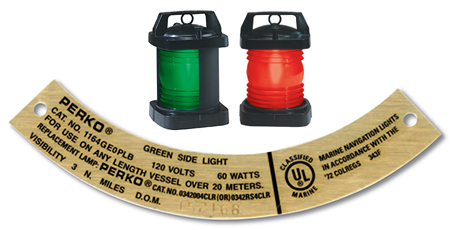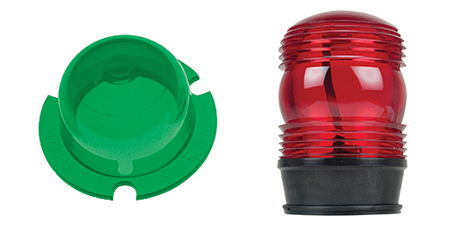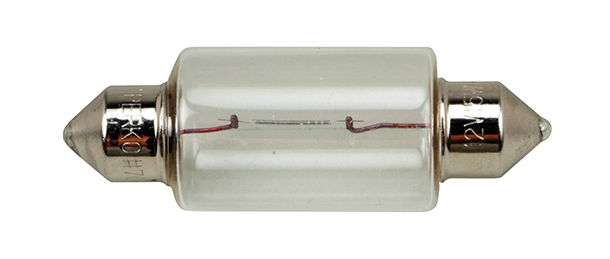FAQ's

Select a question below to see the answer
Please contact us and let us know in that you would like to be added to the "Where to Buy" dealer search. Please note that there will be a delay to verify authenticity.
Improved corrosion resistance, more reliable electrical connections and long life in harsh environments.
The U.S. Coast Guard is accepting lights that have passed the UL tests (UL Standard 1104) as meeting the '72 COLREGS and the U.S. Inland Rules for vessels over 20 meters (65.6 ft.). As the first domestic manufacturer to pass UL 1104, Perko's lights can be installed on vessels over 20 meters (65.6 ft.). Perko manufactures two sizes of lights for the large boat market. The first group of lights is for vessels between 20 meters and 50 meters. The second group includes larger lights and is for vessels over 20 meters (without an upper limit on length).
A brass tag is permanently affixed to the light indicating the type of light, catalog number, voltage and bulb type to install to meet the visibility requirements. It also states that the light is classified by UL in accordance with the '72 COLREGS. This is the only documentation needed by a vessel in this size range for navigation lights to certify light construction compliance with the '72 COLREGS and the U.S. Inland rules.

Lights for these boats must be manufactured in accordance with the American Boat and Yacht Council (A.B.Y.C.) Standard A-16. The primary means of certification recognized in the United States for lights for these boats is through the National Marine Manufacturers Association (NMMA) certification procedure. USCG approved lights, as described below, are also approved for these applications.All PERKO small boat lights designed for use on boats built before 11/1/03 are certified under this NMMA Certification Procedure. All lights certified under this procedure are required to permanently carry the mark "A-16" visibly displayed when the light is installed.

The only recognized means of certification of lights for these boats is the USCG approval system. This system uses independent, 3rd party USCG approved labs to conduct some of the tests required for the A-16 certification. On all USCG approved lights, the permanent marking USCG 1nm, USCG 2nm or USCG 3nm (depending on whether the light is a 1-mile, 2-mile or 3-mile light) must be visible when the light is installed. Note that certifications may vary with voltage (e.g. USCG approved for 12-volt and A-16 certified for 24-volt).

On March 31, 1977, the U.S. Coast Guard published, in the Federal Register, an amendment to the navigation and navigable water regulations which added a new subchapter DD, (33 CFR 87). This subchapter contains rules implementing and interpreting the International Regulations for Preventing Collisions at Sea, 1972 ('72 COLREGS). The International Regulations for Preventing Collisions at Sea, 1960, were replaced by the '72 COLREGS at 1200 hours, zone time on July 15, 1977. Therefore, all vessels on the high seas must comply with the '72 COLREGS at this time. In addition, with the enactment of the U.S. Inland Navigation Rules Act of 1980, the Inland Rules, Western Rules, and Great Lakes Rules were unified into a single set of requirements. The effective date for this legislation was December 24, 1981 (March 1, 1983 for Great Lakes). Therefore, all vessels must comply with these rules at this time.
Rules 21 and 22 of the '72 COLREGS and the U.S. Inland Navigation Rules give the color and range requirements for various navigation lights. Annex 1 to the '72 COLREGS and the U.S. Inland Navigation Rules gives positioning and technical details for these lights.
U.S. Coast Guard Acceptance of Navigation Lights
All U.S. Registered vessels are subject to either the '72 COLREGS or the U.S. Inland Rules. The U.S. Coast Guard is accepting lights that have passed the UL tests (UL Standard 1104) as meeting the '72 COLREGS and the U.S. Inland Rules for vessels over 20 meters (65.6 ft.) in length. U.S. requirements for smaller vessels are less strict. As the first domestic manufacturer to pass UL 1104, Perko's lights can be installed on vessels over 20 meters (65.6 ft.) in length. Some models are designed for use on vessels over 20 meters (65.6 ft.) in length, while others are designed for use on vessels 20 meters (65.6 ft.) to 50 meters (164.0 ft.) in length.
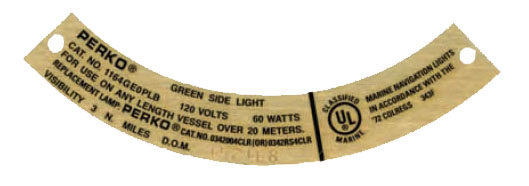
A brass tag is permanently affixed to the light (see image below) indicating the type of light, catalog number, voltage and bulb type to install to meet the visibility requirements. It also states that the light is classified by UL in accordance with the '72 COLREGS. This is the only documentation needed by a vessel for navigation lights to certify light construction compliance with the '72 COLREGS and the Inland Navigation Rules, and eliminates the former "Certificate of Compliance".
Each Light has its own Serial Number for Identification
The lights indicated for use on vessels over 20 meters (65.6 ft.) in length have passed UL 1104. The facsimile of the tag shown above is used on our cast bronze lights. Similar rectangular tags are used on other style lights.
Please note that any changes made to PERKO navigation lights, including substitution of bulbs other than those shown in our catalog, instruction sheets, or metal tags (affixed to some lights) will void all certifications and U.S. Coast Guard acceptance.
For the present, the U.S. Coast Guard will not publish a list of UL classified lights. However, field offices have been notified. For more detailed information, consult the complete '72 COLREGS, the U.S. Inland Navigation Rules, and your local U.S. Coast Guard office.
Special Purpose Lights
Other lights (not shown) for use where the vessel is subject to special local requirements are available. Contact Perko for further information.
When standing outside - if the door opens away from you, then you need a Lock or Latch with a Regular Bevel. If the door opens toward you, then you need a Lock or Latch with a Reverse Bevel. See image below for additional help.

NOTE: The privacy latch handle should always be mounted on the door's interior side.
Battery disconnect switches help manage the overall use of electrical power on board. They are used to connect or disconnect electrical devices from the electrical system. They help to prevent battery drain during periods of inactivity. They allow for a quick and easy way to shut down the entire electrical system in an emergency. An optional key lock helps to prevent unauthorized use of the vessel.
In addition to doing everything a battery disconnect switch does, battery selector switches permit battery selection (of two or more batteries) for specific purposes including starting engines, running accessories or even recharging. They allow for the use of one or more batteries in systems with one or more engines and facilitate putting batteries in parallel for emergency starting when one or both batteries are substantially discharged.
All Perko battery disconnect switches and battery selector switches are UL listed, ignition protected and CE approved. This means they have been tested and certified by a respected outside agency, are designed to be used safely in a bilge where explosive fumes may be present and meet all the requirements for use and sale throughout the world.
Perko battery switches are designed for surface mounting. Standard duty switches have a bright red polycarbonate housing for safety with a large easy-to-turn black knob. The housing of the heavy duty switches are red fiber-reinforced polycarbonate. Selector switches are designed with a "make before break" feature. This allows switching between the "1", the "all" and the "2" positions while the engine is running. Models with an "Alternator Field Disconnect" Feature offer protection for Non-Unitized Alternators should the switch accidentally be turned to the "Off" position with the engine running.
Single Engine, Single Battery

Single Engine, Two Batteries
Switch Position indicates which battery (#1, All, #2) is connected to the engine.
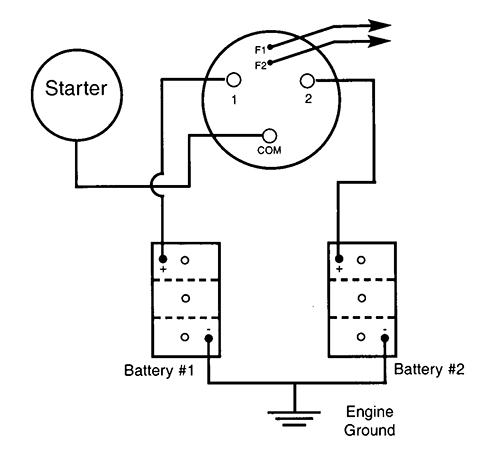
Two Engine, Two Batteries, Two Switches
This allows either engine to be started by either battery. Port switch indicates which battery (#1, All, #2) is connected to the port engine and the starboard switch indicates which battery (#1, All, #2) is connected to the starboard engine.
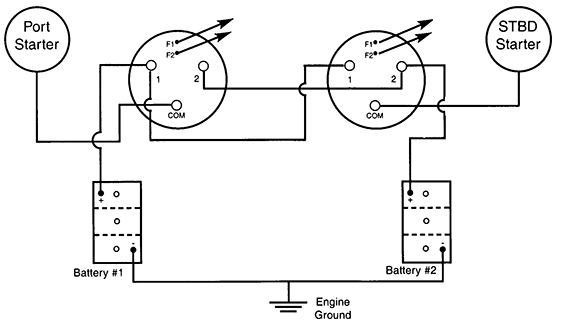
Two Engine, Two Batteries, A Separate Bank of Lighting Batteries and Two Switches
The allows both engines to be used to charge Lighting Batteries. Port switch indicates which battery (port only, port lighting only) is connected to the port engine and the starboard switch indicates which battery (starboard only, starboard lighting only) is connected to starboard engine.

Click the button below to see a demonstration on how to wire a selector switch and to access the various battery switch wiring diagrams.
Yes! Check out the Legacy section on our website for more information on accessing older Perko product catalogs.
No Saved Products


